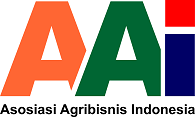The Potential of Black Pepper Farmer Groups: One of The Strategic Policies in Strengthening Farmer Groups
Abstract
One spice that has many functions and benefits is pepper. Pepper is widely cultivated by farmers involved in farmer groups. The role of farmer groups as institutions is able to coordinate the marketing of black pepper so as to improve the bargaining position of farmers. The aims of this study were to the potential of black pepper farmer groups in East Lampung. To obtain the necessary data, this research uses a survey method. The data used in this research are primary and secondary data, which are then processed using qualitative methods. The main data was collected through direct observation at the research location as well as in-depth interviews with 21 administrators and members of the Sido Makmur farmer group, which were conducted using questionnaires from June to October 2022. Data analysis to answer the objectives using qualitative descriptive analysis To analyze problems and analysis potentials faced by farmer groups in increasing market expansion using qualitative descriptive analysis and Focus Discussion Groups (FGD) in order to find internal factors (strengths and weaknesses) and external factors (opportunities and challenges) faced by farmer groups Sido Makmur in increasing the expansion of the black pepper market. The characteristics of farmers include the average age of productive age, the average level of formal education of junior and senior high school graduates, the average area of land cultivated by farmers is above 1 ha, as well as internal and external factors as strategic analysis variables (internal factors: farmer's social capital consists of social networks and good trust, institutions, sufficient group capacity, group characteristics in the form of capital, profits, and limited resources, and external factors: External Factors Policy, where several stakeholders have been assisted in the transfer of science and technology).
Keywords
References
Amam, A., Jadmiko, M. W., Harsita, P. A., & Poerwoko, M. S. (2019). Model Pengembangan Usaha Ternak Sapi Perah Berdasarkan Faktor Aksesibilitas Sumber Daya. Jurnal Sain Peternakan Indonesia, 14(1), 61-69. https://doi.org/10.31186/jspi.id.14.1.61-69
Ambarwati, K., Nurmayasari, I., & Prayitno, R. T. (2020). Hubungan Karakteristik Petani Dan Perilaku Komunikasi Petani Dalam Pemenuhan Informasi Usahatani Lada Di Desa Sukadana Baru, Kecamatan Marga Tiga, Kabupaten Lampung Timur. JIIA, 8(2), 280-286. https://jurnal.fp.unila.ac.id/index.php/JIA/article/view/4065
Anantanyu, S. (2011). Kelembagaan Petani: Peran Dan Strategi Pengembangan Kapasitasnya. 7(2), 102-109.
Anwar, M. S., Hasyim, A. I., & Affandi, M. I. (2018). Analisis Kelayakan Finansial Usaha Pembibitan Lada Di Desa Sukadana Baru Kecamatan Marga Tiga Kabupaten Lampung Timur. Jurnal Ilmu-Ilmu Agribisnis, 6(2), 110-116. https://doi.org/10.23960/JIIA.v6i2.2775
Balqis, P., & Yanuar, R. (2021). Daya Saing Ekspor Lada Indonesia. Forum Agribisnis (Agribusiness Forum), 11(2), 182-194.
Berliana, D., & Supriyatna, R. (2019). Peningkatan Nilai Tambah Lada Melalui Diversifikasi Pengolahan Sebagai Upaya Penguatan Subsektor Hilir Di Lampung Timur Increasing Pepper ' s Value Added Through Diversification Processing as an Effort to Strengthen the Downstream Subsector in East Lampun. Prosiding Seminar Nasional Pengembangan Teknologi Pertanian IPTEKS, 1964(November), 28-33.
BPS. (2015). Komoditas Jagung Pipilan Indonesia 2015. Accessed: Desember 15, 2023. Available from: https://www.bps.go.id/publication/2015/11/27/6bd0bd97b5c53dc4513a8fa1/distribusi-perdagangan-komoditi-jagung-pipilandi-indonesia-2015.html
Fitrah, H. (2013). Analisis Pemasaran Agribisnis Lada (Piper Nigrum L) Di Desa Mangkauk Kecamatan Pengaron Kabupaten Banjar Kalimantan Selatan. Ziraa'Ah Majalah Ilmiah Pertanian, 38(3), 28-32.
Fraser, T., Aldrich, D. P., & Small, A. (2021). Connecting Social Capital and Vulnerability: Citation Network Analysis of Disaster Studies. Natural Hazards Review, 22(3), 131-144. https://doi.org/10.1061/(asce)nh.1527-6996.0000469
Harahap, M., & Herman, S. (2018). Social Capital Relationship With Vegetable Farmers 'Productivity (Case Study On The Group Of Tani Barokah Village Tanah Enam Ratus District Medan Marelan). Agrium, 21(2), 157-165. https://medium.com/@arifwicaksanaa/pengertian-use-case-a7e576e1b6bf
Hartanti, M. I., Fajrina, A., Agatis, J., & Dramaga, K. (2021). Potensi Perdagangan Komoditas Lada dari Indonesia ke Vietnam sebagai Salah Satu Pasar Non-Tradisional. Jurnal Ekonomi Dan Kebijakan Pembangunan, 10(1), 55-71.
Hasan, N. (2009). Strategi Penguatan Kelompok Tani Dalam Pengembangan Usaha (Kasus Kelompok Tani Karya Agung Desa Giriwinangun, Kecamatan Rimbo Ilir, Kabupaten Tebo Provinsi Jambi). Institut Pertanian Bogor.
Hermanto, H., & Swastika, D. K. S. (2011). Analisis kebijakan pertanian (Agricultural policy analysis). Jurnal Analisis Kebijakan Pertanian, 9(4), 371-390.
Hermawan, H., & Andrianyta, H. (2013). Peran Tambahan Modal Terhadap Pendapatan Usahatani Padi. Jurnal Pengkajian Dan Pengembangan Teknologi Pertanian, 16(2), 132-139.
Imadudin, I. (2016). Perdagangan Lada Di Lampung. Patanjala, 8(3), 349-364.
Indarti, I. (2015). Model Peningkatan Kesejahteraan Masyarakat Pesisir Berkelanjutan. Jurnal Dinamika Ekonomi Dan Bisnis, 12(1)(1), 63-75.
Kementan. (2020). Buku Outlook Komoditas Perkebunan Lada. In Pusat Data dan Sistem Informasi Pertanian.
Langit, A. A. I. D. S., & Ayuningsasi, A. A. K. (2019). Pengaruh Luas Lahan, Tenaga Kerja, dan Modal Terhadap Produksi Usaha Tani Jeruk. E-Jurnal EP Unud, 8(8), 1757-1788.
Listyati, D., Wahyudi, A., & Hasibuan, A. M. (2014). Penguatan Kelembagaan Untuk Peningkatan Posisi Tawar Petani Dalam Sistem Pemasaran Kakao. J.TIDP, 1(1), 15-28.
Pradnyawati, I. G. A. B., & Cipta, W. (2021). Pengaruh Luas Lahan, Modal dan Jumlah Produksi Terhadap Pendapatan Petani Sayur di Kecamatan Baturiti. Ekuitas: Jurnal Pendidikan Ekonomi, 9(1), 93. https://doi.org/10.23887/ekuitas.v9i1.27562
Pradyatama, M. P., Hasyim, A. I., Situmorang, S., Agribisnis, J., Pertanian, F., Lampung, U., Prof, J., & Brodjonegoro, S. (2019). Sistem Pemasaran Lada Hitam Di Kabupaten Lampung Barat Provinsi Lampung. 7(4), 491-498.
Puspita, Y. (2020). Modal Sosial Dan Kesejahteraan Kelompok Tani Tebu. Media Trend, 15(1), 29-40. https://doi.org/10.21107/mediatrend.v15i1.5774
Putnam, R.(1995). Bowling alone: America's declining social capital. Culture and Politics: A Reader. 42(25), 65-78.
Rahayu, S. E., & Harahap, M. (2018). Model Peningkatan Daya Saing Petani Dengan Pendekatan Koperasi Agribisnis di Kota Medan. JASc (Journal of Agribusiness Sciences), 2(1), 18-25. https://doi.org/10.30596/jasc.v2i1.2590
Rumagit, J., Timban, J. F. J., & Ngangi, C. R. (2019). Peranan Modal Sosial Pada Kelompok Tani Padi Sawah Di Desa Tawaang Kecamatan Tenga Kabupaten Minahasa Selatan. Agri-Sosioekonomi, 15(3), 453. https://doi.org/10.35791/agrsosek.15.3.2019.26116
Sari, R. F. M., Prasmatiwi, F. E., & Abidin, Z. (2022). Analisis Finansial Pengembangan Usahatani Lada Di Kecamatan Abung Tengah Kabupaten Lampung Utara. Jurnal Ilmu-Ilmu Agribisnis, 10(1), 1. https://doi.org/10.23960/jiia.v10i1.5643
Shaliha, M. B., Jahroh, S., & Johar, S. (2017). Strategi Pengembangan Agribisnis Lada Putih di Provinsi Kepulauan Bangka Belitung. Jurnal Pendidikan Tambusai, 6(2), 13719.
Syofian, S., Sujianto, S., & Handoko, T. (2020). Modal Sosial Kelembagaan Petani Karet di Kabupaten Kuantan Singingi. Gulawentah:Jurnal Studi Sosial, 5(1), 52-. https://doi.org/10.25273/gulawentah.v5i1.6388
Tedjaningsih, T., & Sufyadi, D. (2020). Modal Sosial dan Keberlanjutan Usahatani Mendong. MIMBAR AGRIBISNIS, 6(2), 588-599.
Thampi, A., & Bhai, R. S. (2017). Rhizosphere actinobacteria for combating Phytophthora capsici and Sclerotium rolfsii, the major soil borne pathogens of black pepper (Piper nigrum L.). Biological Control, 109, 1-13.
Waluyo, S. (2021). Seminar Nasional Insinyur Profesional ( SNIP ) Analisis dan Strategi Pengembangan Sistem Agribisnis Lada Di Provinsi Lampung.
DOI: https://doi.org/10.37046/jaj.v0i0.24318
Refbacks
- There are currently no refbacks.
Copyright (c) 2024 Authors

This work is licensed under a Creative Commons Attribution-NonCommercial-ShareAlike 4.0 International License.
Jambura Agribusiness Journal (P-ISSN: 2685-5860, E-ISSN: 2685-5771) is licensed under a Creative Commons Attribution-NonCommercial-ShareAlike 4.0 International License. Powered by Public Knowledge Project OJS










